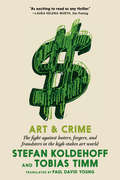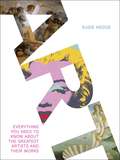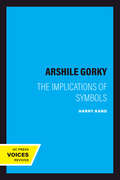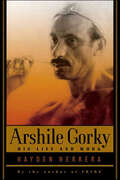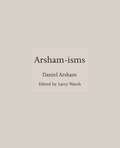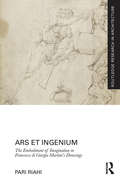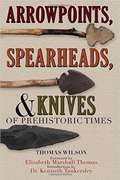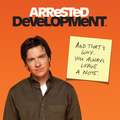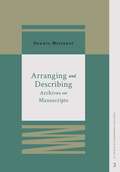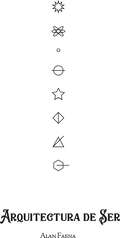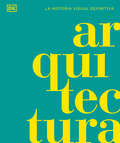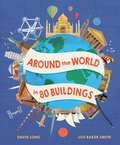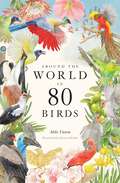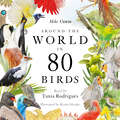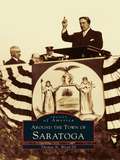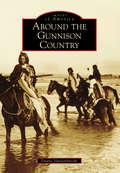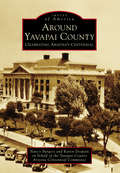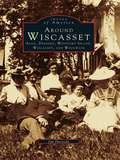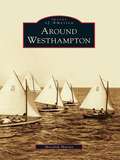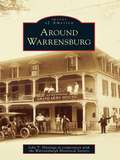- Table View
- List View
Art & Crime: The fight against looters, forgers, and fraudsters in the high-stakes art world
by Stefan Koldehoff Tobias TimmA thrilling, eye-popping look at true crime in the billion-dollar art world.The art world is one of the most secretive of global businesses, and the list of its crimes runs long and deep. Today, with prices in the hundreds of millions for individual artworks, and billionaires' collections among the most conspicuous and liquid of their assets, crime is more rampant than ever in this largely unregulated universe. Increased prices and globalization have introduced new levels of fraud and malfeasance into the art world--everything from "artnapping," in which an artwork is held hostage and only returned for a ransom, to forgery and tax fraud. However, the extent of the economic and cultural damage that results from criminality in the global art scene rarely comes to light. The stories of high-stakes, brazen art crimes told by art experts Stefan Koldehoff and Tobias Timm are by turns thrilling, disturbing, and unbelievable (the imagination for using art to commit crimes seems boundless). The authors also provide a well-founded analysis of what needs to change in the art market and at museums. From the authors of False Pictures, Real Money (about the Beltracchi art forgery case), Art and Crime includes a chapter on art owned by Donald Trump. It is a thoroughly researched, explosive, and highly topical book that uncovers the extraordinary and multifarious thefts of art and cultural objects around the world.
Art & Beauty
by Maurice de WulfThis work attempts to establish a philosophy of art that is both intellectual and objective. At first sight it may appear that these goals are at variance with contemporary ideas. On closer examination, however, the reader will see that the tendency is in the opposite direction, a closer approach to present-day thought rather than a departure from it. To admit that there exists a world other than that of our subjective states is to subscribe to an interpretation more in keeping with the real, and thus also with artistic reality. The intellectual and objective philosophy to which this book appeals in order to interpret the beauty of art will not be an intrusion, if it guards against all exclusiveness and does not itself compromise that which gives it its value.
Art
by Susie HodgeFrom the influential craftsmen of the high renaissance to the Dutch masters, and from the rococo and neoclassical movements of the 18th century to romanticism, modernism and contemporary art, the lives of the great artists are as varied and multifaceted as the works of creative genius they produced.The Great Art Guide introduces readers to 100 of the world's most important artists, from the 13th century to the present. Works by artists such as Caravaggio, Vermeer, van Gogh and Warhol are arranged chronologically and set in their historical context by Susie Hodge's authoritative narrative.Succinct and insightful artist profiles are accompanied by high-quality reproductions of the individual's most significant works of art. Including a glossary of key terms and a comprehensive list of the most important art institutions from across the globe, this concise and readable guide is a joy for students of art or anyone wanting to know more about great works of art.
Arshile Gorky: The Implications of Symbols
by Harry RandThis title is part of UC Press's Voices Revived program, which commemorates University of California Press’s mission to seek out and cultivate the brightest minds and give them voice, reach, and impact. Drawing on a backlist dating to 1893, Voices Revived makes high-quality, peer-reviewed scholarship accessible once again using print-on-demand technology. This title was originally published in 1991.This title is part of UC Press's Voices Revived program, which commemorates University of California Press’s mission to seek out and cultivate the brightest minds and give them voice, reach, and impact. Drawing on a backlist dating to 1893, Voices Revived</DIV
Arshile Gorky: His Life and Work
by Hayden HerreraFrom the Author of Frida, the Moving and Heroic Story of One of the Central Painters of the Twentieth CenturyBorn in Turkey around 1900, Vosdanik Adoian escaped the massacres of Armenians in 1915 only to watch his mother die of starvation and his family scatter in their flight from the Turks. Arriving in America in 1920, Adoian invented the pseudonym Arshile Gorky-and obliterated his past. Claiming to be a distant cousin of the novelist Maxim Gorky, he found work as an art teacher and undertook a program of rigorous study, schooling himself in the modern painters he most admired, especially Cézanne and Picasso. By the early forties, Gorky had entered his most fruitful period and developed the style that is seen as the link between European modernism and American abstract expressionism. His masterpieces influenced the great generation of American painters in the late forties, even as Gorky faced a series of personal catastrophes: a studio fire, cancer, and a car accident that temporarily paralyzed his painting arm. Further demoralized by the dissolution of his seven-year marriage, Gorky hanged himself in 1948.A sympathetic, sensitive account of artistic and personal triumph as well as tragedy, Hayden Herrera's biography is the first to interpret Gorky's work in depth. The result of more than three decades of scholarship-and a lifelong engagement with Gorky's paintings-Arshile Gorky traces the progress from apprentice to master of the man André Breton called "the most important painter in American history."
Arsham-isms (ISMs)
by Daniel ArshamA collection of compelling quotations from a rising star in contemporary art, architecture, and designThe work of renowned contemporary artist Daniel Arsham blurs the lines between art, architecture, archeology, and design. In his distinctive style, he takes ancient art works and objects from twentieth-century pop culture and casts sculptures of them in geological materials such as quartz or volcanic ash, colliding past, present, and future in haunted yet playful visions that prompt viewers to question their everyday surroundings. Gathered from interviews and other sources, Arsham-isms is a collection of lively, thought-provoking, and memorable quotations from this exciting young creative talent on a wide range of subjects—including art, architecture, film, design, pop culture, the art world, and what it means to be a globally recognized artist today.Select quotations from the book:“Art needs to be a little dangerous.”“You don’t have to own the thing to be part of it.”“This work for me is not about progress. It is about destruction and growth and where they are able to meet in the middle.”
Ars et Ingenium: The Embodiment Of Imagination In Francesco Di Giorgio Martini's Drawings (Routledge Research in Architecture)
by Pari RiahiWhen did drawing become an integral part of architecture? Among several architects and artists who brought about this change during the Renaissance, Francesco di Giorgio Martini’s ideas on drawing recorded in his Trattati di architettura, ingegneria e arte militare (1475-1490) are significant. Francesco suggests that drawing is linked to the architect’s imagination and central in conveying images and ideas to others. Starting with the broader edges of Francesco’s written work and steadily penetrating into the fantastic world of his drawings, the book examines his singular formulation of the act of drawing and its significance in the context of the Renaissance. The book concludes with speculations on how Francesco’s work is relevant to us at the onset of another major shift in architecture caused by the proliferation of digital media.
Arrowpoints, Spearheads, and Knives of Prehistoric Times
by Elizabeth Marshall Thomas Thomas Wilson Kenneth Barnett TankersleyA thorough history of the weapons and tools our prehistoric ancestors used to survive, this book reveals a world that will fascinate anyone interested in outdoor skills, ancient weapons, or anthropology. Thomas Wilson explains the many types of arrowheads, spears, and knives used by the peoples of the Paleolithic period across Western Europe and the early days of America. He details the materials from which these tools were made, how and where they were manufactured, and the purposes for which they were crafted—from hunting and cutting to scraping and grinding. Lavishly illustrated with hundreds of drawings of these tools, including microscopic details of the flint and other stones from which they were crafted, this is a rare look into what seems like mankind's not-so-distant past.
Arrested Welcome: Hospitality in Contemporary Art
by Irina AristarkhovaInterpreting the meaning of hospitality in an unwelcoming political moment Amid xenophobic challenges to America&’s core value of welcoming the tired and the poor, Irina Aristarkhova calls for new forms of hospitality in her engagement with the works of eight international artists. In this first monograph on hospitality in contemporary art, Aristarkhova employs a feminist perspective to critically explore the artworks of Ana Prvački, Faith Wilding, Lee Mingwei, Kathy High, Mithu Sen, Pippa Bacca, Silvia Moro, and Ken Aptekar and asks who, how, and what determines who is worthy of our welcome. Spanning a diverse range of contemporary art practices, Arrested Welcome shows how artists challenge our existing notions of hospitality—culturally, philosophically, and politically. From the role of &“microcourtesies&” in social change to the portrayal of waiting as a feminist endeavor, Aristarkhova looks deeply into topics such as gender stereotypes of welcome, ways to reclaim civility, and the means by which guests (sometimes human, sometimes animal) push the limits of our hosting traditions. Blending a feminist analysis of hospitality with in-depth case studies on how contemporary artists stimulate personal reflection and political engagement, Aristarkhova initiates these important conversations at a critical time of national and international hospitality crises.
Arrested Development: And That's Why . . . You Always Leave a Note.
by Arrested DevelopmentAnd now the story of a wealthy family who lost everything, and the one son who had no choice but to keep them all together . . . ItOCOs "Arrested Development. " Meet the formerly wealthy and habitually dysfunctional Bluth family. When the family patriarch George Sr. is sent to prison for shifty accounting practices, the Bluths must face reality?or not. Since the family assets have been frozen and the family business is in jeopardy, it looks like they may have to give up their lavish lifestyle. Worse yet, they may have to go out and get jobs The only one who seems to understand the seriousness of their predicament is Michael, who realizes itOCOs up to him to guide his eccentric family into this new chapter of their lives: Chapter 11. Full of the most memorable quotes and images from some of the best moments from the original three seasons of the show, "Arrested Development: And ThatOCOs Why . . . You Always Leave a Note" offers valuable life lessons from Michael, G. O. B. , Lucille, George Sr. , Lindsay, George Michael, Tobias, and the rest of the Bluth gang with chapters including: Family First, Huge Mistakes, Parental Guidance, Risky Business, and more. Relive all your favorite A"rrested Development" moments with this must-have companion to the ground-breaking comedy series. "
Arranging and Describing Archives and Manuscripts
by Dennis MeissnerArrangement and description lie at the very heart of the archival endeavor. While all archival functions are crucial and interdependent, arrangement and description transform the potential value of materials into practical, usable value for researchers and others. In this book, the author provides a solid foundation in the history, theory, and standards supporting arrangement and description. In addition, he clearly demonstrates the approaches, methods, and mechanics required to process archival collections. The processing landscape has changed considerably in the last decade: archivists focus more on the economics of processing, descriptive standards have matured and increased in number, new technologies and viewpoints have challenged long-standing assumptions, and evolving systems and software have changed the mechanics of metadata capture and serialization and our approaches to those fundamental processes. This is a must-read book for every archivist practicing today.
Arquitectura (Architecture): La historia visual definitiva
by DK¿Por qué las estructuras romanas han sobrevivido después de tanto tiempo? ¿Cómo se sostienen los altos techos de las catedrales góticas?¿Conoces las innovaciones arquitectónicas que están ayudando a combatir el cambio climático? Resuelve tus dudas, explora cada período y estilo arquitectónico de la historia en profundidad y recorre los edificios más icónicos del mundo con Arquitectura. La guía visual definitiva. Un libro que analiza el desarrollo de la arquitectura a lo largo de más de 6000 años, mostrando los materiales de construcción, la tecnología, el diseño y los cambios sociales que han dado forma a las estructuras arquitectónicas que conocemos hoy en día. Edificios de todo el mundo, incluidos el Templo del Cielo de China, el Pabellón Dorado de Japón, el Taj Mahal de la India, el Gran Zimbabue de África, la Pirámide del Sol de América del Sur y Persépolis de Oriente Medio.Información detallada de los principales estilos arquitectónicos y un resumen de los elementos y las características principales de cada uno de ellos.Impresionantes e ilustraciones en 3D que te permitirán identificar y ver con más detalle las decoraciones, los elementos estructurales clave y los edificios más famosos de cada período.Descubre todo sobre la arquitectura por períodos y estilos, desde las viviendas más antiguas hasta los rascacielos de última tecnología. Completo, autorizado e inspirador, este libro es perfecto para cualquier persona fascinada por este arte y que quiere saber más sobre sus técnicas, las construcciones que hay repartidas por el mundo y los factores sociales y culturales que las han hecho posibles.From ancient dwellings to modern high-tech skyscrapers, discover everything there is to know about the history of architecture around the world.Covering more than 6,000 years of human history, Architecture charts the most important developments in building materials, technology, and design, and the social changes that have shaped the architectural landscape. Explore every significant architectural period and style in depth through key examples. Take a tour of some of the world’s most iconic buildings, beautifully illustrated with a combination of stunning photography and specially commissioned CGI illustrations. Find out why so many ancient Roman structures have withstood the test of time. Learn how the soaring ceilings of Gothic cathedrals are held up. And discover the architectural innovations that are helping combat climate change. Comprehensive, authoritative, and inspiring, Architecture is the perfect book for anyone fascinated by the built world – its visual character and the factors that have formed it - and who wants to understand more
Around the World in Cut-Outs
by PaperboyoGlobe-hopping artist Paperboyo transforms real iconic landmarks and settings around the world into works of art and amusement by just holding up a cut-out and snapping a photo. Here is New York's Guggenheim Museum as a flowerpot, the Eiffel Tower sporting butterfly wings, a giant octopus peeking its tentacles out of the Roman Colosseum, and nearly a hundred more images of wonder and humor. Organized into categories such as Quirky Architecture, Pop Culture, and Playing with Food, the book also covers Paperboyo's process with these topics:• Behind the Scenes• The Fails• D.I.Y.Featuring favorites from his wildly popular Instagram feed plus many never-before-seen delights, entertaining captions, behind-the-scenes, and cut-outs for readers to make their own images, Around the World in Cut-outs encourages a different and delightful view of the world around us.
Around the World in 80 Buildings (Around the World in 80 #6)
by David LongWhere can you eat dinner under the sea? Which country has the most pyramids? Can a church become a swimming pool?Including a stunning central gatefold map that opens out to reveal where all 80 structures are located, this book is a visual celebration of the incredible structures people have built throughout history and their cultural significance. From ancient wonders such as Stonehenge to bridges spanning countries, record breaking rollercoasters and hotels where even the beds are made of ice.Discover a floating palace, a terracotta army, a cinema in a bank vault, and a building so tall that clouds form at the top!
Around the World in 80 Birds
by Mike UnwinThis beautiful and inspiring book tells the stories of 80 birds around the world: from the Sociable Weaver Bird in Namibia which constructs huge, multi-nest 'apartment blocks' in the desert, to the Bar-headed Goose of China, one of the highest-flying migrants which crosses the Himalayas twice a year.Many birds come steeped in folklore and myth, some are national emblems and a few have inspired scientific revelation or daring conservation projects. Each has a story to tell that sheds a light on our relationship with the natural world and reveals just how deeply birds matter to us.
Around the World in 80 Birds
by Mike UnwinThis beautiful and inspiring book tells the stories of 80 birds around the world: from the Sociable Weaver Bird in Namibia which constructs huge, multi-nest 'apartment blocks' in the desert, to the Bar-headed Goose of China, one of the highest-flying migrants which crosses the Himalayas twice a year.Many birds come steeped in folklore and myth, some are national emblems and a few have inspired scientific revelation or daring conservation projects. Each has a story to tell that sheds a light on our relationship with the natural world and reveals just how deeply birds matter to us.
Around the World in 80 Birds
by Mike UnwinThis beautiful and inspiring book tells the stories of 80 birds around the world: from the Sociable Weaver Bird in Namibia which constructs huge, multi-nest 'apartment blocks' in the desert, to the Bar-headed Goose of China, one of the highest-flying migrants which crosses the Himalayas twice a year.Many birds come steeped in folklore and myth, some are national emblems and a few have inspired scientific revelation or daring conservation projects. Each has a story to tell that sheds a light on our relationship with the natural world and reveals just how deeply birds matter to us.
Around the Town of Saratoga
by Thomas N. Wood IIIAs the American struggle for independence intensified, Saratoga became a focal point of warring activities. Both colonists and loyalists maintained forts, camps, and officer headquarters within town. In 1777, after the two Battles of Saratoga, American forces gained the surrender of BritishGen. John Burgoyne, thus turning the tide of the Revolutionary War. The name Saratoga comes from the Mohawk word meaning either "place of the swift water" or "hillside country of the great river." True to its name, the town spreads across rolling hills along the western side of the Hudson River. The river itself, together with two early main roads and a canal, brought prosperity to the area. Saratoga became a major shipping terminal. The town boundaries changed several times throughout the years, but the rural character of the town and the spirit of its residents remained constant.
Around the Gunnison Country (Images of America)
by Duane VandenbuscheThe Gunnison country, 4,000 square miles of high valleys, heavy snows, deep canyons, and 14,000-foot-high mountains, is one of Colorado's most beautiful regions. Located on the Western Slope of Colorado, the Gunnison country has a long history involving Native Americans, mining, narrow-gauge railroads, ranching, Western State Colorado University, and recreation. The region has also been influenced by nearby Lake City in the San Juan Mountains, Aspen in the Elk Mountains, and towns on the east side of the famed and historic Alpine Railroad Tunnel. Today, the Gunnison country still is beautiful and tranquil, hosting nearly 2,000,000 visitors yearly while remaining much the same as it was over 125 years ago.
Around the Corner Crochet Borders: 150 Colorful, Creative Edging Designs with Charts and Instructions for Turning the Corner Perfectly Every Time
by Edie EckmanA crochet border is the perfect finishing touch on the edges of any fiber project, but creating one often means shaping the edging around an unforgiving 90-degree angle. It&’s no easy task, but Edie Eckman guides you through it with style and poise. This collection includes 150 vibrant crochet frames to suit every fiber need, with color photographs by John Polak that showcase the beautiful details of each technique. Now painless, marvelous crochet borders are just around the corner!
Around Yavapai County: Celebrating Arizona's Centennial
by Nancy Burgess Karen Despain Yavapai County Arizona Centennial CommitteeOn February 23, 1863, Pres. Abraham Lincoln signed the bill creating the Territory of Arizona. The first Arizona Territorial Legislature established the capital at Prescott and met in September 1864. They divided the territory into four counties: Mohave, Pima, Yavapai, and Yuma. Yavapai County, the "mother county," consisted of approximately 65,000 square miles and was believed to be the largest county in the United States. By the time Arizona attained statehood on February 14, 1912, there were 14 counties, and Yavapai County had been reduced in size to 8,125 square miles. Yavapai County has a rich history in mining, ranching, farming, military, and business. Today, Yavapai County is a thriving, growing county with nine incorporated cities and towns and numerous unincorporated communities, such as Ash Fork, Black Canyon City, Cornville, Mayer, and Skull Valley. Historic sites include Sharlot Hall Museum in Prescott, the town of Jerome, Fort Verde, Montezuma's Castle and Well, and Tuzigoot.
Around Wiscasset: Alna, Dresden, Westport Island, Wiscasset, and Woolwich (Images of America)
by Jim HarnedyThe Kennebec and Sheepscot Rivers of Maine, naturalboundaries for the Wiscasset region, provided the water highways for early explorers, traders, andmissionaries. By the early part of the seventeenth century, colonization by European settlers had begun. For over 360 years, the area has been home to shipbuilders, fishermen, farmers, and tradesmen. This marvelous photographic chronicle traces not onlythe rich historical traditions of the area, but also the shared sense of life's unbroken continuity present in the towns of the Wiscasset region: Alna, Dresden, Westport Island, Wiscasset, and Woolwich. Vintage photographs profile a few of those who quietly inspired others through their efforts to make life better in the region, as well as those men and women of wealth and vision who provided the area with a legacy by their lifestyles and great homes. The book also features views of local taverns, courthouses, general stores, churches, and schools--all the foundations of a changing, vivacious, and growing community.
Around Westhampton
by Meredith MurrayRenowned as part of the Hamptons, the area known today as Westhampton, Westhampton Beach, Quiogue, and West Hampton Dunes was named Catchaponack by the Algonquin tribes who lived in the area when the English sheepherders arrived in the 1660s. A land of breathtakingly beautiful beaches and bays situated on the south shore of Long Island, just 65 miles east of New York City, Westhampton has evolved from an agricultural and fishing village to a summer vacation resort to a year-round oceanfront community. Fortune 500 chief executive officers and celebrities, such as Cary Grant, Charles Addams, and Marvin Hamlisch, have lived quietly amid locals. Together they have survived hurricanes, outlasted raucous night clubs, rebuilt eroded dunes, and fought off real estate developers. Around Westhampton depicts how an area blessed with uncommon physical beauty has managed to remain unspoiled in the face of natural disasters and international fame.
Around Warrensburg (Images of America)
by John T. Hastings Warrensburgh Historical SocietyWilliam Bond became the first Warrensburg settler, when he arrived in the Echo Lake area, in 1787. Shortly thereafter, Warrensburg became known as "the Bridge" because it was the location of the only bridge in the area that crossed the Schroon River. In February 1813, the town of Warrensburg was formed from part of Thurman. By the mid-1800s, A. C. Emerson and B. P. Burhans had moved to Warrensburg and begun to harness the waterpower of the Schroon River and utilize the nearby timber resource. The Emerson sawmill and Burhans's tannery and gristmill provided employment and capital to support a growing and thriving town. Other industries, such as a woolen mill and pants factory, sash and blind factory, shirt factory, and shoe peg factory, soon followed. With the dawn of the 20th century, improved transportation in the form of railroads and the automobile began bringing more people to Warren County. This trend continues today as numerous visitors summer in the Adirondacks to enjoy the clean air and water of the north country.
